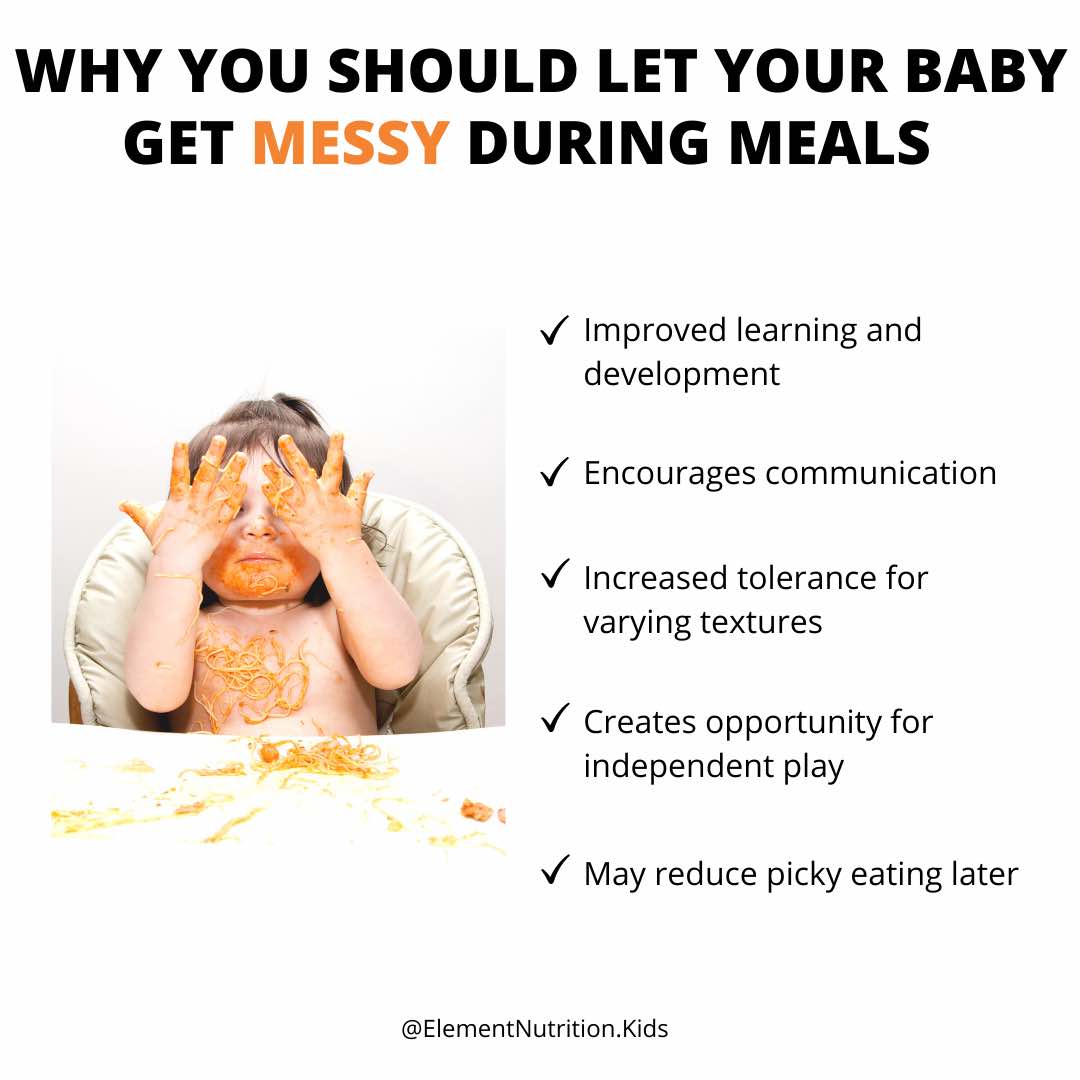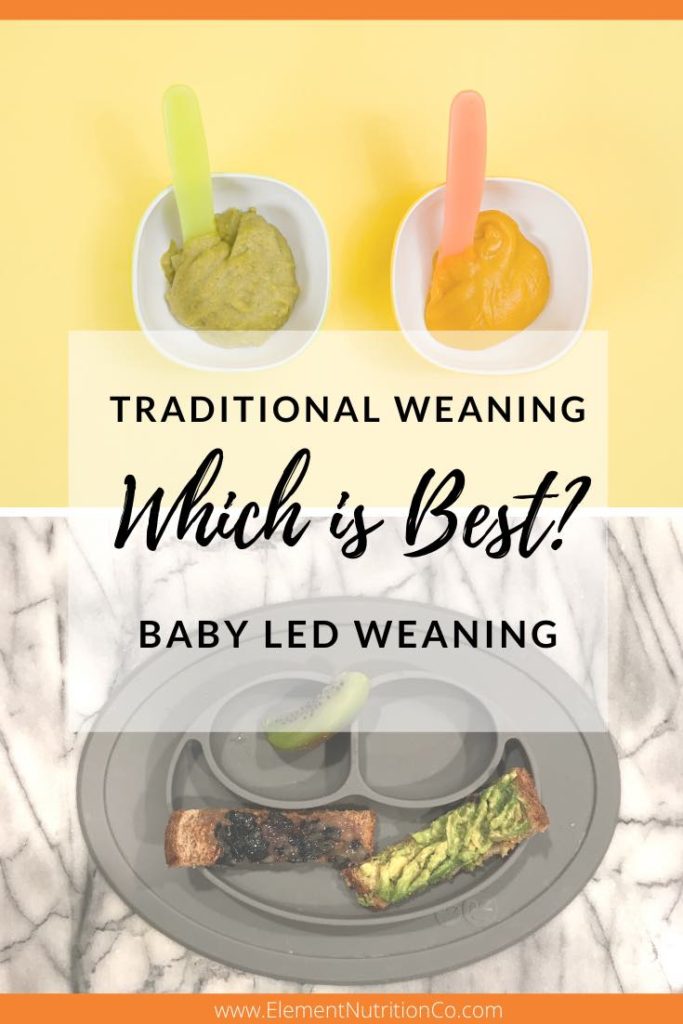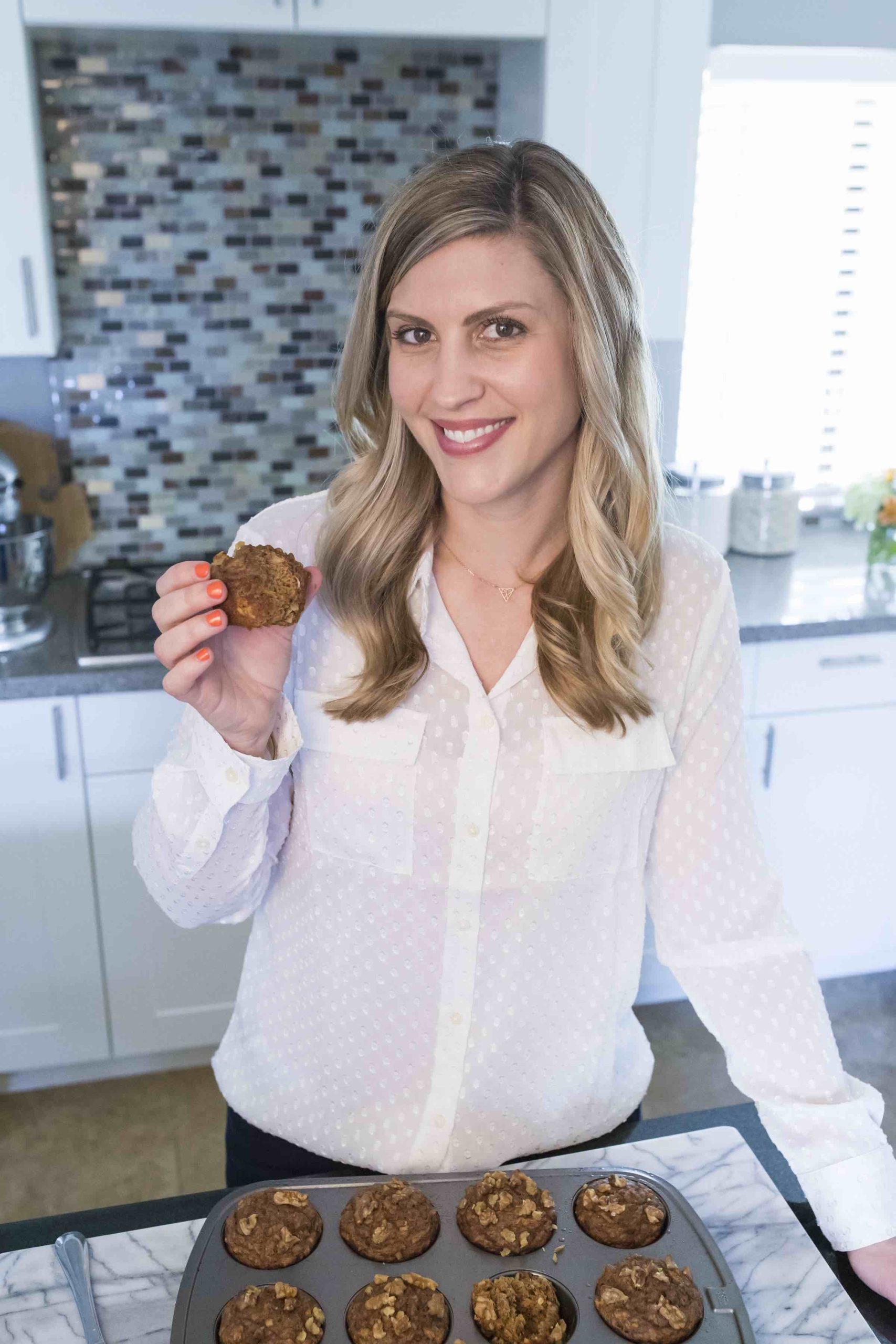A few years ago I started getting lots of questions from parents about baby-led weaning. While this isn’t a “new” method of feeding, it is “newer” (in the past 5-10 years) in the United States. As a pediatric dietitian, I knew that fully understanding this approach to feeding was going to be key to helping the parents I work with make the best decision for their families. Fast forward a few years when I found out I was having a baby of my own, this feeding decision became even more personal.
If you are on the fence about the feeding method you will use, or, you simply want to know more about the differences, pros, and cons of each, then keep on reading. I am going to walk you through the biggest things you need to know when deciding on the method that is best for your baby.
Table of Contents
Traditional weaning
With the traditional weaning method, food is introduced in a puree form and the texture progresses over time. When you start feeding, the food is pureed, so it usually requires the parent/caregiver to spoon-feed the baby. When the texture progresses to a thick puree, you can load the spoon and hand it to your baby to practice self-feeding.
With the traditional feeding method, it is important to start baby with fruits, vegetables, meats and iron-fortified grains from the very beginning. (Stay tuned for another post in this series on the best first foods for your baby.)
One common misconception is that foods need to be introduced one at a time or one before the other. There is no solid evidence supporting the introduction of just one food at a time.
Babies have an innate preference for sweets, so they will likely prefer fruits whether you introduce them before or after vegetables, meats etc. It is best to offer baby a variety of foods and flavors from the start so that the key nutrient needs are met. This is true of both feeding methods, but especially important with the traditional weaning method, as many of the jarred baby foods are primarily fruits and vegetables.
Spoon feeding
If you plan to start solids using the traditional weaning method, you will likely need to start by spoon feeding. There are a few best practices to keep in mind with spoon feeding so you can help create a responsive feeding environment.
- Ensure the environment is distraction free. (No TV or toys, parents should be sitting face to face with the baby making eye contact.)
- Let your baby get messy.
- Avoid constantly wiping or scraping food off your baby’s face or around their mouth (This can be uncomfortable and can cause the baby to dislike the feeding process)
- Don’t scrape the spoon on the roof of their mouth to get food off the spoon. Let baby pull the food off the spoon on their own. Using shallow spoons or flat spoons are best for this.
- Aim the spoon toward the sides of the mouth not straight back in the mouth, so your baby can practice chewing.
- Progress through the textures appropriately, do not stay on thin/smooth purees too long.
Introducing textured food to baby
One of the most important things when following the traditional weaning method is that you are introducing textured food to your baby at the right times. Staying on pureed texture too long can make the transition harder. Your baby needs to learn how to move chunkier baby foods around in their mouth so they can progress to table foods. The goal is for your baby to be on table foods by 9-11 months.
It is also important to continue transitioning the texture so that your baby can develop the oral and motor skills they need.
Here is a rough outline:
- Around 6 months (not before 4): start with thin puree and transition to thicker puree as tolerated by your baby. Babies that start solids around 6 months likely won’t need a thin puree, but if you are starting sooner they might.
- By 7-8 months: start the transition from puree to mashed/lumpy textures. You can do this by fork mashing cooked foods.
- By 9 months (6-9 months): start encouraging self-feeding with hands (mostly using palm-palmar grip). Self-feeding foods should be shaped like fingers so your baby can easily pick them up. (Some examples are: sticks of very well steamed carrots, avocado slices, banana cut lengthwise and rolled in chia seeds or crushed baby cereal for grip, very thin slices of tender meats, roasted sweet potato sticks, etc.) It is okay to still spoon feed lumpy textures in addition to self-feeding.
- Around 9-11 months: your baby should be eating table foods. During this time your baby will start being able to pick up foods with their fingers (pincer grip). Allow them to practice by giving them small pieces of foods to pick up (toast cut into small squares, iron-fortified cereal o’s, egg omelet cut into small squares, soft cooked vegetable pieces, halved blueberries, small pieces of pancake etc.)
- By 12 months: your baby should be eating fully chopped finger foods.
- 12-24 months: they should be eating a combination of chopped finger foods and foods that your baby can take small bites of (larger pieces of toast with butter, small sandwiches etc.)
Benefits of traditional weaning
Each weaning method has its pros and cons, however, one of the biggest pros of traditional weaning is confidence in knowing that your baby has consumed the food you provided. With purees, the parent tends to be more in control and therefore they know how much baby ate. This could be viewed as both a pro and a con.
Iron is one of the key foods needed when babies are starting solids and many iron-rich foods are more difficult for baby to chew and swallow using the baby led weaning method.
Providing iron-rich purees (fortified cereals, meats, beans) is one way to make sure your baby is meeting their iron needs.
Some babies, especially those with developmental delays or prematurity may need to start with the traditional weaning method. This is not to say that these babies cannot follow the baby led weaning method or a combination approach, they just may need to work more closely with a healthcare team to do so.
Most parents feel more confident that their baby will not choke following the traditional weaning method. Though, the risk for choking depends on foods provided throughout each stage of the feeding process. There is more on choking hazards below. Baby’s following both weaning methods can stay safe from choking by avoiding the key hazards.
The key with traditional feeding is to make sure you are following responsive feeding practices. This means you are letting your baby guide the feeding process by letting you know when they are hungry and full.
What is baby led weaning
Baby led weaning is a method of feeding your baby whole foods starting from their first bite. This method takes puree foods out of the equation and instead of the parent spoon feeding their baby, the baby picks up and eats foods by themselves.
This method of feeding is built on the idea that once developmentally ready (around 6 months), a baby has the innate ability to understand their own body and has the competence to get foods to their mouths. With baby led weaning the goal is to allow for exploration of food, but meeting baby’s key nutrient needs is also still important.
For those using the baby led weaning method of starting solids, it is critical to wait until the baby is developmentally ready, which typically occurs around the 6-month mark. Each baby’s readiness is different so understanding your baby’s cues is especially important.
Many people feel that the baby led weaning method creates a more responsive feeding environment, putting your baby fully in the driver’s seat of feeding. As a parent, you can create a responsive feeding environment regardless of the method of feeding you choose.
With strict baby led weaning, no puree foods are included. However, many healthcare professionals and parents enjoy following a modified baby led weaning approach that includes whole foods along with some purees (self-fed by baby). This method of feeding was supported by the Bliss Study (Baby Led Introduction to Solids) and is my personal favorite weaning method. This is the approach I used with my daughter.
Common concerns with baby led weaning
Like most parenting topics the best feeding method for baby’s is highly controversial. My advice to parents is always to educate themselves on the different approaches so they can make the best decision for them and their baby. Below are a few of the most common concerns parents have about the baby led weaning approach.
Does baby led weaning increase risk of choking?
Choking is one of the top concerns of the baby led weaning method. Starting babies on whole foods from their first bite makes many parents squirm.
One thing to keep in mind is that parents often confuse choking and gagging. Understanding the difference is important if you are considering the baby led weaning method of feeding.
If your baby is choking, they are not likely to be making noises. This occurs when the airway is blocked by food. Anytime you feed your baby there is some risk of choking, so it is important to know what to do by becoming CPR certified or be familiar with infant CPR before your baby is starting solids. I always recommend parents grab this American Red Cross CPR Ready Guide.
Most of the research shows that as long as parents avoid or modify foods that are a choking hazard, there is no increased risk of choking between feeding methods. In studies examining choking risk between the baby led weaning and traditional weaning methods babies in both groups had choking episodes when given unsafe foods.
Common choking hazards
Avoid or modify these foods for babies and kids 5 years old & under.
- Raw apple, carrot, celery or other hard uncooked fruits/vegetables
- Round foods like grapes, whole nuts, olives, and hot dogs/sausages
- Dried fruits like raisins or prunes if not cut down smaller
- Popcorn (this is an especially dangerous one)
- Chunks of peanut butter
- Marshmallows
- Hard candies
Choking vs. gagging
As opposed to choking, gagging is a response mechanism that moves food that hasn’t been chewed well enough back toward the front of the mouth to be chewed more thoroughly. It may result in coughing, sputtering noises, watery eyes, or a look of fear on baby’s face. Your baby may also be silently but consciously working on moving food forward in the mouth. This can be scary to parents. When I was first starting my daughter on solid foods, even with my education and experience, this was scary to me.
It is important to remember that gagging is a normal reflex that is part of learning to eat. Gagging is a good thing!
Gagging occurs with puree foods too. Your baby is still learning the movement of food in their mouths, which requires skill, strength, and repetition. It is important to be there for support, but try not to have an alarmed reaction to gagging or it could also alarm your baby.
Is my baby eating enough?
It is possible for your baby to get enough to eat with baby led weaning as long as you are providing the right foods. They need a solid combination of foods that are high in iron, fat/energy, and fiber as well as a variety of textures. Stay tuned for another post coming up on important foods for baby led weaning.
The main source of energy (calories) for your baby is still coming from breastmilk and formula. When you start your baby on solid foods, the goal is for foods to meet the gap in what your baby gets from thier milk and what they need for growth.
To date, there has been one major study comparing nutrient intake between baby led weaning and traditional feeding and they found no significant difference between methods as long as parents were providing appropriate foods.
Finger foods for babies without teeth
One of the most common questions I hear from parents is “how will my baby eat solid foods without teeth?” Let me assure you, babies do not need teeth to eat! Most babies don’t develop their chewing teeth (molars) until much later (closer to the two-year mark for many babies.) You don’t want to wait for molars to give them solid food.
The front teeth are great for biting, but aside from that, teeth don’t matter much when starting solids. As long as you provide your baby soft foods, they can eat a pretty good variety.
Foods to offer:
- Steam hard fruits/vegetables until they are soft
- Cut slices of meat thin so they are tender and can suck the juices out
- Avoid common choking hazards (always quarter any round foods)
- Provide foods that are high in fat. (Avocado, eggs (whole egg), foods cooked with plant-based oils and creamy nut butter spread on toast or mixed into yogurt or cereal)
- Provide foods the length and shape of your finger to allow babies to hold and chew them until they develop their pincer grip (fingers)
- Give a variety of finger foods
Benefits of baby led weaning
There are many potential benefits to following the baby led weaning method of feeding. However, many of these benefits are also true of the traditional weaning method. The key is to follow responsive feeding practices.
Improved oral motor skills
Your Baby is more likely to begin chewing before swallowing with the baby led weaning method. When babies are introduced to pureed foods first, they often learn to swallow before chewing. Baby led weaning allows your baby to gum food and practice chewing to self-manage different textures at their own pace. Self-feeding can increase baby’s confidence and fosters more attempts at traversing different shapes and textures. Baby led weaning also offers more time to play and explore.
Naturally creates a responsive feeding environment
When a baby is self-feeding, they are determining what food goes into their mouth. They get to pick which foods they eat and the order in which they eat it. They also get to decide how much they eat. Babies will not overfeed themselves.
May develop a more adventurous eater
Feeding your baby with the baby-led weaning method, usually provides more variety in food and texture. This helps babies develop a taste for a wide range of food from the start. This does not mean that spoon-fed babies cannot be adventurous eaters. It all depends on the parent’s willingness to offer new flavors and textures.
Many potential benefits have been identified for the baby led weaning approach. However, a 2018 systematic review (research summary) determined that there isn’t enough evidence to say that the baby-led weaning approach is best (yet). Much of the research that supports baby-led weaning is not high quality. The highest-quality studies are randomized control trials, which are difficult with this topic. Most of the baby-led weaning studies depend on self-reported information from parents, which often can be incorrect.
Benefits of letting baby get messy
One of the best benefits of the baby-led weaning feeding method is that your baby is in control of the feeding process. This means they usually get a bit messier than spoon-fed babies. Allowing babies to get messy is a huge benefit for their sensory development and may improve their willingness to try new things. Babies who are constantly getting their faces and hands wiped down by their parents may develop issues with textures in the future. Do your baby a huge service and let them get messy!

Which method is best-traditional or baby-led weaning?
You have probably figured out that there is no one best way to feed your baby. Each method: baby-led weaning and traditional weaning, has its pros and cons. My advice to you is to do the method you feel most comfortable and confident with. A comfortable, relaxed, confident parent will produce a more relaxed baby.
The most important part of starting solids with your baby is creating a good food environment while meeting nutrition needs.
How to get extra support with starting solids
If you’re getting ready to start your baby on solid foods and could use some extra support through the process. Be sure to check out my comprehensive e-book “Baby’s First Bites” which walks you through everything you need to know (including sample meals and menus to make things easier.)
You can also schedule a 1:1 consult to chat with me about working together.


